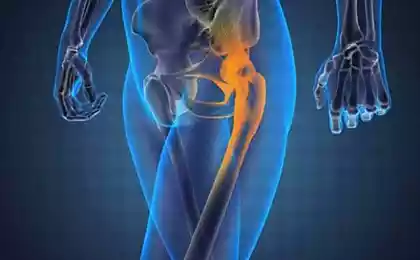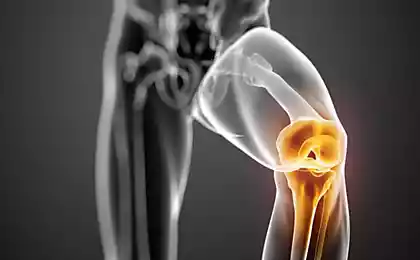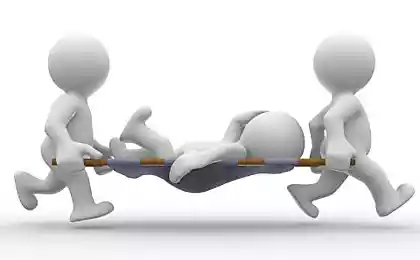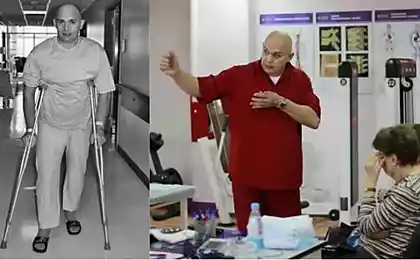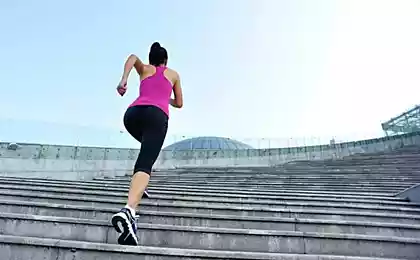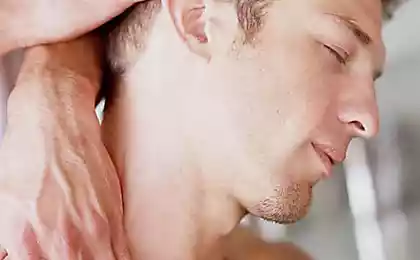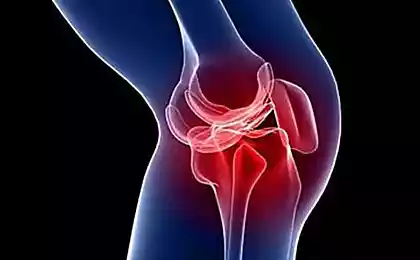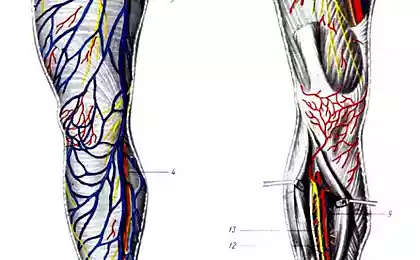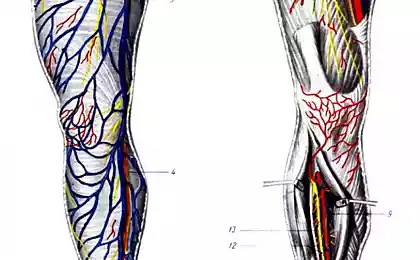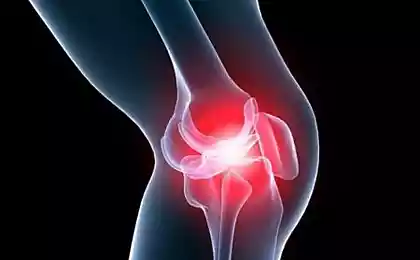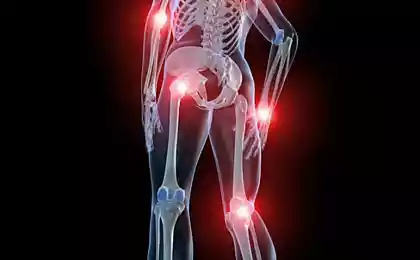607
Exercises in dislocation of the shoulder joint
Dislocations of the shoulder joint is in the leading place in prevalence among all types of dislocations. According to the head position of the shoulder as a result of dislocation klassificeret front, rear and lower dislocations. Anterior dislocation occurs in an overwhelming majority, the bottom is much rarer, and the frequency of rear dislocation does not exceed 0.1—0.2% of all cases. Basically, front dislocations of the shoulder joint are the result of indirect violence or falling forward on an outstretched, notirovannyh and taken outwards hand.
Symptoms of anterior dislocation is very specific and characteristic. Change the contours of the shoulder joint: it is the outer part normally has a rounded form, and if flattened anterior dislocation. Moreover, the injured side of the shoulder girdle a little shortened than healthy. In the case of axillary dislocation of the humeral head is located under the glenoid cavity, the shoulder is substantially withdrawn from the body, sometimes even to a horizontal position.
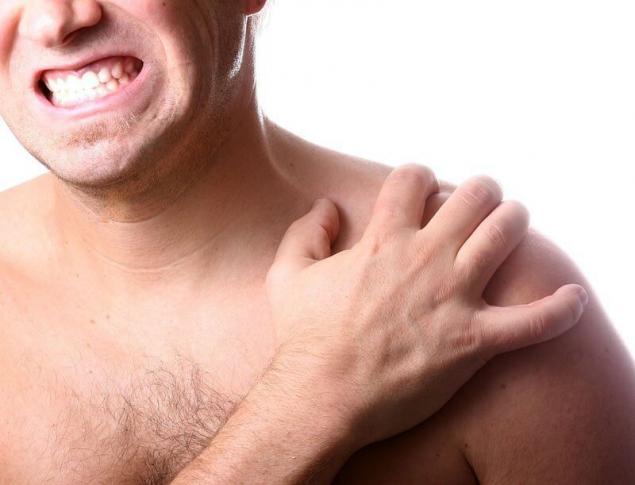
After dislocation of the humeral head is reduced, the necessary immobilization of the limb for 3-4 weeks using the desault bandage or plaster splint. In the first period of adaptation, in addition to restorative exercises and exercises in the joint healthy hand, is assigned the execution of active movements in joints of fingers and wrist joint of the injured limb. It is recommended to apply isometric tension in the muscles of the arm and forearm. The muscles tense when the patient attempts to move the shoulder, elbow and wrist joints. It is recommended to perform such exercises of physiotherapy with dislocation of the shoulder joint rotation with active movements in the joints of the other limbs are healthy.
The second period takes place after immobilization. Injured arm of the patient put on a wide scarf for a period of 14-21 days. In this period after the cessation of immobilization, it is important to achieve relaxation of muscles, a reflex twitch. This helps to ensure that the patient at implementation of motions will not suffer from pain.
The beginning of the second period must be accompanied by classes, based on simple exercises for the muscles of the limb and of the whole belt of the upper extremities. Such exercises include convergence of the blades, lifting the shoulder girdle, the circular movements of small amplitude in the shoulder joint, flexion-extension, abduction with a short delay arm in extreme positions of motion. These exercises are performed without removing the damaged hand with scarves. Some of the exercises recommended in helping with his good hand, then range of motion can be increased. Over time, mastering the weight of the hands and reduce pain in vivanta joint some of the exercises are starting to run out of scarves. The complexity of such exercises should be increased gradually so as not to stretch the capsule of the shoulder joint and periarticular tissue, as they haven't quite matured to that period of rehabilitation.
3-4 weeks after the injury begins another stage in which to perform the exercises with clubs, balls, and gymnastic stick. Aft of this, movement in the shoulder joint, active abduction in the affected arm across the smooth surface. Perform this exercise bent and bent by hand while lying on your back. In the same position recommended exercises to strengthen the muscles located around the shoulder joint: abduction of the limb when resistance, which has Methodist, stretching the rubber bandage, overcoming the weight of the load and more.
The third period is given mainly to recover strength, endurance training of muscles, which strengthen the shoulder joint and muscles of the shoulder and upper extremity. To achieve these goals of therapeutic exercise should include special exercises for block devices, using resistance bands, dumbbells, rubber bandages. In addition, it is recommended to actively engage in occupational therapy: working with a hacksaw, planer, and various household tasks, such as cleaning of premises, work in the garden and the garden and other things related to the self.
A set of special exercises in the first period
1. I. P. — standing. Leg, the namesake of the injured arm, extended a step forward while the torso is tilted forward in the direction of the paralyzed hand. You must use the healthy hand to pull the patient's hand from the gusset plate (if you do not leaning forward in the direction of the patient's hands, in the region of the fracture there is a sharp pain). In this position, perform a pendulum swinging relaxed her arm back and forth. Perform 6-10 times.
2. I. p. — same. Perform a circular motion clockwise and counterclockwise in a horizontal plane. Perform 6-10 times.
3. I. p. — same. Throwing arm forward and the torso backward. Perform 6-10 times.
4. I. p. — same. The fingers clench into a fist (once the thumb should be on the outside, once inside), then straighten. Perform 6-10 times. Through this exercise, there is resorption of extensive hemorrhage, which occurs in fractures of the arm and forearm.
5. I. p. — same. Bend your arm at the elbow at the weight, then straighten. Perform 6-10 times.
6. I. p. — same. Hand to put into the scarf, to bend it at the elbow at a right angle. To move the arm from right to left and Vice versa, and then to take forward and lead to the body in front of chest. Perform 6-10 times.
7. I. p. — same. Hand to take samsungu at the neck, pivot elbow forward, then squeeze the arm to the torso. Perform 6-10 times.
8. I. p. — same. Arm to put in the Windows, straightened, then lift shoulders and lower. Blades to keep and breed. Perform 6-8 times.
A set of special exercises in the second period
1. I. p. — standing, feet shoulder width apart, torso bent forward, hands hanging at your sides. To perform a pendulum movement with your hands forward and backward. Do 10 times.
2. I. p. — same. Perform a circular motion, rukario clockwise and counter-clockwise (in the horizontal plane). Do 10 times.
3. I. p. — same. Hands take right, then left, and Vice versa. To execute 10 times.
4. I. p. — same. Hands to "throw" forward, then over the trunk back with cotton and without cotton. Repeat 10 times.
5. I. p. — same. To perform a double screen flapping hands in front of chest (hands should alternate right and left at the top). Repeat 10 times.
6. I. p. — same. Hands clench into "lock", then bend them at the elbows, bring the chin and lower then to his forehead and lowered. Then put your hands on the parietal part of the head so that between the shoulder and the body formed a right angle, then hands down. Perform 10-12 times.
When the patient will be able to put his hands on his head, he can do exercises 7-12.
7. I. p. — same. In the lowered hands — the stick. Hands to perform different movements in all directions. Perform 10-15 times.
8. I. p. — standing against the wall, feet shoulder width apart, arms along the body. To move the hands on the wall up and down, thus it is impossible to remove the patient's hand from the wall, not lowering it tentatively along the wall down, otherwise the shoulder joint will there is a sharp pain. In the case of pain, you need to quickly perform exercise 1 from the complex of the first period. This exercise will help to remove the pain.
9. I. p. — standing, feet shoulder width apart, in the lowered hands the ball. Throw the ball and catch with both hands. Repeat 10-15 times.
The following exercises 10 through 12 are performed on the block. At home, the unit is made as follows: take a spool without thread and a long nail, the nail pierced rectangular piece of cardboard so that the nail head does not slip into the hole of the coil. Then the nail Assembly in the coil is driven into the lintel of the doorway, and pounced on the coil cord with two loops. And, due to the rotation of the coil, the cord moves.
10. I. p. — standing, holding hands on the loop of cord. To raise and lower the patient's hand. Do 10-15 times.
11. I. p. — same. Hands bent in front of him, then bent to take his hands back. Perform 10-15 times.
12. I. p. — same. Hands to dissolve in hand, then return to the starting position. Perform 10-15 times.
In addition, in the complex of therapeutic physical training included exercises in the water.
The complex of exercises in water
1. I. P. — sitting or standing in water. To perform movements that mimic the swimming styles of "rabbit" and "brass".
2. I. P. — lying in the water on the belly. Perform a circular motion with your hands in the water and double screen motion with his hands in front of chest.
3. I. P. — lying on its side damaged hands. Injured arm bent at the elbow, then straighten. Then perform a bent arm in a circular motion in the shoulder joint clockwise and counterclockwise.
4. I. P. — sitting on his haunches in the water. To perform a flapping motion with my hands in the water back and forth and double screen (right and left hand on top). published
P. S. And remember, only by changing their consumption — together we change the world! © Join us at Facebook , Vkontakte, Odnoklassniki
Source: healthinfo.ua/articles/zdrovie_uprazhnenia/25816
Symptoms of anterior dislocation is very specific and characteristic. Change the contours of the shoulder joint: it is the outer part normally has a rounded form, and if flattened anterior dislocation. Moreover, the injured side of the shoulder girdle a little shortened than healthy. In the case of axillary dislocation of the humeral head is located under the glenoid cavity, the shoulder is substantially withdrawn from the body, sometimes even to a horizontal position.

After dislocation of the humeral head is reduced, the necessary immobilization of the limb for 3-4 weeks using the desault bandage or plaster splint. In the first period of adaptation, in addition to restorative exercises and exercises in the joint healthy hand, is assigned the execution of active movements in joints of fingers and wrist joint of the injured limb. It is recommended to apply isometric tension in the muscles of the arm and forearm. The muscles tense when the patient attempts to move the shoulder, elbow and wrist joints. It is recommended to perform such exercises of physiotherapy with dislocation of the shoulder joint rotation with active movements in the joints of the other limbs are healthy.
The second period takes place after immobilization. Injured arm of the patient put on a wide scarf for a period of 14-21 days. In this period after the cessation of immobilization, it is important to achieve relaxation of muscles, a reflex twitch. This helps to ensure that the patient at implementation of motions will not suffer from pain.
The beginning of the second period must be accompanied by classes, based on simple exercises for the muscles of the limb and of the whole belt of the upper extremities. Such exercises include convergence of the blades, lifting the shoulder girdle, the circular movements of small amplitude in the shoulder joint, flexion-extension, abduction with a short delay arm in extreme positions of motion. These exercises are performed without removing the damaged hand with scarves. Some of the exercises recommended in helping with his good hand, then range of motion can be increased. Over time, mastering the weight of the hands and reduce pain in vivanta joint some of the exercises are starting to run out of scarves. The complexity of such exercises should be increased gradually so as not to stretch the capsule of the shoulder joint and periarticular tissue, as they haven't quite matured to that period of rehabilitation.
3-4 weeks after the injury begins another stage in which to perform the exercises with clubs, balls, and gymnastic stick. Aft of this, movement in the shoulder joint, active abduction in the affected arm across the smooth surface. Perform this exercise bent and bent by hand while lying on your back. In the same position recommended exercises to strengthen the muscles located around the shoulder joint: abduction of the limb when resistance, which has Methodist, stretching the rubber bandage, overcoming the weight of the load and more.
The third period is given mainly to recover strength, endurance training of muscles, which strengthen the shoulder joint and muscles of the shoulder and upper extremity. To achieve these goals of therapeutic exercise should include special exercises for block devices, using resistance bands, dumbbells, rubber bandages. In addition, it is recommended to actively engage in occupational therapy: working with a hacksaw, planer, and various household tasks, such as cleaning of premises, work in the garden and the garden and other things related to the self.
A set of special exercises in the first period
1. I. P. — standing. Leg, the namesake of the injured arm, extended a step forward while the torso is tilted forward in the direction of the paralyzed hand. You must use the healthy hand to pull the patient's hand from the gusset plate (if you do not leaning forward in the direction of the patient's hands, in the region of the fracture there is a sharp pain). In this position, perform a pendulum swinging relaxed her arm back and forth. Perform 6-10 times.
2. I. p. — same. Perform a circular motion clockwise and counterclockwise in a horizontal plane. Perform 6-10 times.
3. I. p. — same. Throwing arm forward and the torso backward. Perform 6-10 times.
4. I. p. — same. The fingers clench into a fist (once the thumb should be on the outside, once inside), then straighten. Perform 6-10 times. Through this exercise, there is resorption of extensive hemorrhage, which occurs in fractures of the arm and forearm.
5. I. p. — same. Bend your arm at the elbow at the weight, then straighten. Perform 6-10 times.
6. I. p. — same. Hand to put into the scarf, to bend it at the elbow at a right angle. To move the arm from right to left and Vice versa, and then to take forward and lead to the body in front of chest. Perform 6-10 times.
7. I. p. — same. Hand to take samsungu at the neck, pivot elbow forward, then squeeze the arm to the torso. Perform 6-10 times.
8. I. p. — same. Arm to put in the Windows, straightened, then lift shoulders and lower. Blades to keep and breed. Perform 6-8 times.
A set of special exercises in the second period
1. I. p. — standing, feet shoulder width apart, torso bent forward, hands hanging at your sides. To perform a pendulum movement with your hands forward and backward. Do 10 times.
2. I. p. — same. Perform a circular motion, rukario clockwise and counter-clockwise (in the horizontal plane). Do 10 times.
3. I. p. — same. Hands take right, then left, and Vice versa. To execute 10 times.
4. I. p. — same. Hands to "throw" forward, then over the trunk back with cotton and without cotton. Repeat 10 times.
5. I. p. — same. To perform a double screen flapping hands in front of chest (hands should alternate right and left at the top). Repeat 10 times.
6. I. p. — same. Hands clench into "lock", then bend them at the elbows, bring the chin and lower then to his forehead and lowered. Then put your hands on the parietal part of the head so that between the shoulder and the body formed a right angle, then hands down. Perform 10-12 times.
When the patient will be able to put his hands on his head, he can do exercises 7-12.
7. I. p. — same. In the lowered hands — the stick. Hands to perform different movements in all directions. Perform 10-15 times.
8. I. p. — standing against the wall, feet shoulder width apart, arms along the body. To move the hands on the wall up and down, thus it is impossible to remove the patient's hand from the wall, not lowering it tentatively along the wall down, otherwise the shoulder joint will there is a sharp pain. In the case of pain, you need to quickly perform exercise 1 from the complex of the first period. This exercise will help to remove the pain.
9. I. p. — standing, feet shoulder width apart, in the lowered hands the ball. Throw the ball and catch with both hands. Repeat 10-15 times.
The following exercises 10 through 12 are performed on the block. At home, the unit is made as follows: take a spool without thread and a long nail, the nail pierced rectangular piece of cardboard so that the nail head does not slip into the hole of the coil. Then the nail Assembly in the coil is driven into the lintel of the doorway, and pounced on the coil cord with two loops. And, due to the rotation of the coil, the cord moves.
10. I. p. — standing, holding hands on the loop of cord. To raise and lower the patient's hand. Do 10-15 times.
11. I. p. — same. Hands bent in front of him, then bent to take his hands back. Perform 10-15 times.
12. I. p. — same. Hands to dissolve in hand, then return to the starting position. Perform 10-15 times.
In addition, in the complex of therapeutic physical training included exercises in the water.
The complex of exercises in water
1. I. P. — sitting or standing in water. To perform movements that mimic the swimming styles of "rabbit" and "brass".
2. I. P. — lying in the water on the belly. Perform a circular motion with your hands in the water and double screen motion with his hands in front of chest.
3. I. P. — lying on its side damaged hands. Injured arm bent at the elbow, then straighten. Then perform a bent arm in a circular motion in the shoulder joint clockwise and counterclockwise.
4. I. P. — sitting on his haunches in the water. To perform a flapping motion with my hands in the water back and forth and double screen (right and left hand on top). published
P. S. And remember, only by changing their consumption — together we change the world! © Join us at Facebook , Vkontakte, Odnoklassniki
Source: healthinfo.ua/articles/zdrovie_uprazhnenia/25816

